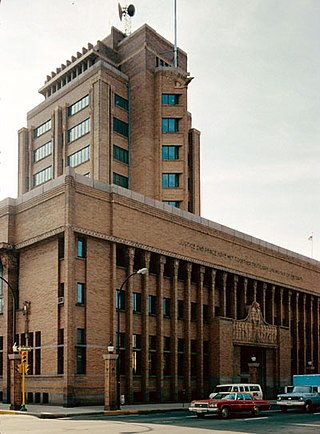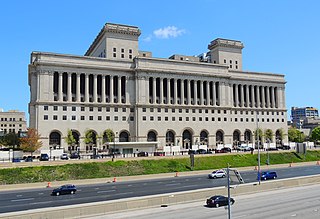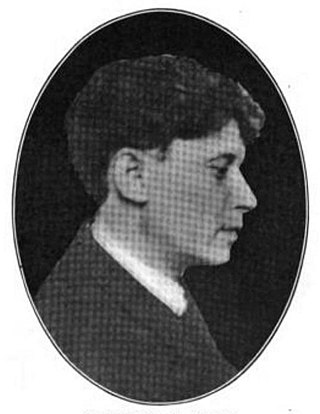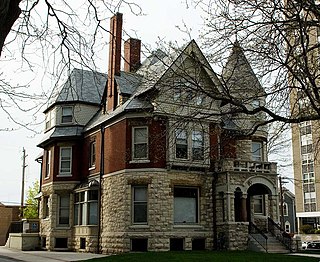
William LaBarthe Steele was an American architect from Chicago, Illinois. He is considered a principal member of the Prairie School Architectural Movement during the early 20th century.

The Milwaukee County Courthouse is a high-rise municipal building located in downtown Milwaukee, Wisconsin. Completed in 1931, it is the third county courthouse to be built in the city and is listed on the National Register of Historic Places. The first two courthouses were built at what is now Cathedral Square Park on the east side of the Milwaukee River.

Forest Home Cemetery is a historic rural cemetery located in the Lincoln Village neighborhood of Milwaukee, Wisconsin and is the final resting place of many of the city's famed beer barons, politicians and social elite. Both the cemetery and its Landmark Chapel are listed on the National Register of Historic Places and were declared a Milwaukee Landmark in 1973.
Purcell & Elmslie (P&E) was the most widely known iteration of a progressive American architectural practice. P&E was the second most commissioned firm of the Prairie School, after Frank Lloyd Wright. The firm in all iterations was active from 1907 to 1921, with their most famous work being done between 1913 and 1921.
Alexander Chadbourne Eschweiler was an American architect with a practice in Milwaukee, Wisconsin. He designed both residences and commercial structures. His eye-catching Japonist pagoda design for filling stations for Wadham's Oil and Grease Company of Milwaukee were repeated over a hundred times, though only a very few survive. His substantial turn-of-the-20th-century residences for the Milwaukee business elite, in conservative Jacobethan or neo-Georgian idioms, have preserved their cachet in the city.

Peter J. Brust was an American architect, and fellow of the American Institute of Architects, who practiced his craft from approximately 1893 to 1946, in Milwaukee, Wisconsin. Brust designed hundreds of residential, ecclesiastical, business, school, medical, public, memorial, recreation, and theater commissions. In 1906, Peter Brust partnered with Richard Philipp and formed the architecture firm of Brust & Philipp. By the 1920s, the firm was the largest architectural firm in Wisconsin. In 1938, Peter Brust established the firm of Brust & Brust with his sons John and Paul. The firm remained in that name until 1973 when it became Brust-Zimmerman.

Lake Park, a mile-long park on a bluff above Lake Michigan in Milwaukee, Wisconsin, is an urban park covering 138.1-acre (559,000 m2).

Ferry & Clas was an architectural firm in Wisconsin. It designed many buildings that are listed on the National Register of Historic Places. George Bowman Ferry and Alfred Charles Clas were partners.
Arnold F. Meyer and/or his firm the Arnold F. Meyer & Co. was a builder in Milwaukee, Wisconsin. The firm was incorporated in 1924. Meyer and his firm built a number of buildings according to designs of architect Ernest Flagg that are listed on the National Register of Historic Places.

Frederick F. Faris (1870–1927) was a Wheeling, West Virginia-based architect.

Midsummer Carnival Shaft is a public artwork by American architect Alfred C. Clas in the Court of Honor, in downtown Milwaukee, Wisconsin, United States. It is on Wisconsin Avenue, between N. 8th and N. 11th Streets.

James O. Douglas was an American architect in Wisconsin. He has been called a "noted Milwaukee society architect".

William Dubois (1879–1953) was an American architect and politician. He was a prolific architect in Wyoming and nearby states, and served five terms in both houses of the Wyoming Legislature.
Emile Weil was a noted architect of New Orleans, Louisiana.
Herbert Wallace Tullgren was an American architect active from the 1910s-1944. He was centered in Milwaukee, Wisconsin, but his work can be seen in different locations throughout Wisconsin, such as Whitefish Bay, Waukesha, Shorewood, and Fond du Lac. His designs made use of Art Deco and Art Moderne, which were popular during the time. Tullgren was the foremost Milwaukee architect practicing in the Art Deco and Art Moderne styles of the early twentieth century.

George Bowman Ferry (1851–1918) was an architect who was a partner in the architectural firm Ferry & Clas.
Kirchhoff & Rose was an architectural firm in Milwaukee, Wisconsin. The partnership began in 1894 between Charles Kirchhoff Jr. and Thomas Leslie Rose.

The Emanuel D. Adler House is a historic 1888 residence built in Milwaukee, Wisconsin, in 1888. It was designed by Milkwaukee architect Alfred Charles Clas. Clas partnered with George Bowman Ferry in 1890 and they formed Ferry & Clas. The partnership continued until Ferry's death.

The Walker's Point Historic District is a mixed working-class neighborhood of homes, stores, churches and factories in Milwaukee, Wisconsin, with surviving buildings as old as 1849, including remnants of the Philip Best Brewery and the Pfister and Vogel Tannery. In 1978 it was added to the National Register of Historic Places. The NRHP nomination points out that Walker's Point was "the only part of Milwaukee's three original Settlements to reach the last quarter of the Twentieth Century with its Nineteenth and early-Twentieth Century fabric still largely intact," and ventures that "For something similar, one would have to travel to Cleveland or St. Louis if, indeed, so cohesive and broad a grouping of...structures still exists even in those cities."

Sauk City High School was established in Sauk City in 1877. A building was constructed for it in 1891. Alfred Clas designed a building for the high school in 1916.















